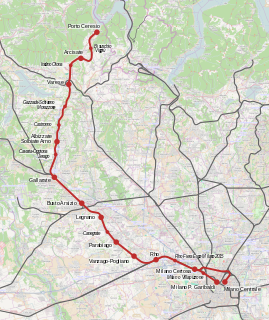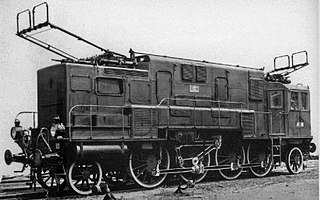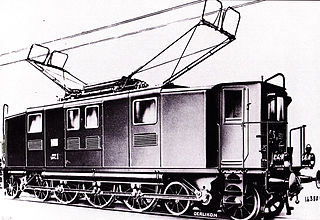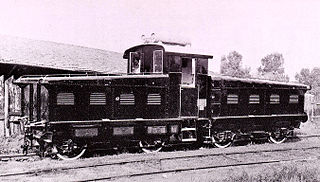
The FS E.625 and E.626 are two classes of Italian electric locomotives produced for the Ferrovie dello Stato. They were introduced in the course of the 1920s and remained in service until the 1990s. The E.626 was the first locomotive fed by 3,000 V DC overhead line in Italy.
Giuseppe Bianchi was an Italian railway engineer on the Ferrovie dello Stato between 1913 and 1946.

Line 2 is a s-train service operated by Trenitalia in the city of Naples, Italy. It connects 12 stations.

Porto Ceresio–Milan railway is a railway line in Lombardy, Italy. It uses the tracks of the Milan–Arona railway until Gallarate.

The Ferrovie dello Stato Class 685 is a class of 2-6-2 'Prairie' express train steam locomotives. These are colloquially known as Regine, mirroring their fame as one of the most successful and appreciated Italian steam locomotives.

The Ferrovie dello Stato Italiane Class 690 was a 4-6-2 'Pacific' steam locomotive for express trains.

The Ferrovie dello Stato Italiane Class 680 is a 2-6-2 express steam locomotive; it was the direct ancestor of the very successful and appreciated Class 685.

The FS Class E.320 was a class of Italian third rail electric locomotive built between 1915 and 1918. Five units were built and they saw service on the Varese - Milan - Porto Ceresio line. They were powered by two direct current electric motors, designed by Tecnomasio Italiano-Brown-Boveri (TIBB), giving a maximum speed of 95 km/h. The final assembly and the mechanical design were by Officine Meccaniche (OM). At the time of their construction they were the most powerful direct current locomotives in the world. The transmission of the motion to the three axles was by connecting rods and these were subject to frequent breakages.

The Class E.321 was an Italian shunting locomotive built from 1959 to 1964. The similar Class E.322 used the same chassis and electric power plan but had no cabin, and was coupled with E.321 to give more output. Both classes were in service with the Ferrovie dello Stato from 1960 until 2002.

The FS Class E.471 locomotives were prototype three-phase AC electric locomotives designed for the Italian State Railways (FS). They constituted the first Italian experiment in using a phase converter. The final goal was to power them with single-phase alternating current, constituting the first case of a European locomotive of this type designed according to modern criteria. However, the difficulty of the development, and political interference, led to the abandonment of the project.

The FS Class E.430 locomotives, initially classed as RA 34, were three-phase alternating current electric locomotives of the Italian railways. They were built for Ferrovia della Valtellina by Ganz and MÁVAG in 1901 and had a power output of 440 kW and a haulage capacity of 300 tons. One locomotive is preserved.

FS Class E.432 was a class of three-phase electric locomotives of the Italian State Railways. Forty of these 1′D1′ locomotives were built in 1928 by Società Ernesto Breda and two have been preserved.

FS Class E.331 was a class of three-phase electric locomotives of the Italian State Railways. Eighteen of these 2′C2′ locomotives were built between 1914 and 1919 by Breda and Brown-Boveri.

FS Class E.332 was a class of three-phase electric locomotives of the Italian State Railways (FS). They were used for the haulage of passenger trains between 1917 and 1963. Designed and built at the same time as the FS Class E.331, they represented an attempt by FS to extend the use of three-phase AC electric traction from primary to secondary routes. Their performance was disappointing and they were relegated to a marginal role, in which they remained despite several modifications.

FS Class E.333 was a class of electric locomotives of the Ferrovie dello Stato (FS), powered by three-phase alternating current, which were in service from 1923 to 1968. They were designed by Kálmán Kandó for hauling fast passenger trains. Having the same electrical equipment as the FS Class E.552 locomotives, they presented the same defects and had to be modified. After modification, they were able to carry out the services for which they were designed.

FS Class E.321 was a class of 17 third-rail electric locomotives, built for the Italian State Railways (FS) for operation on the Varese line and on the underground line in Naples.

The FS Class E.421 locomotive of the Italian State Railways (FS) was a battery electric locomotive, built as a single unit (E.421.1) and used for shunting at the old Milan Central railway station. It was the only battery electric locomotive to be registered in the FS fleet.
FS Class E.620 was a class of third-rail electric locomotives built by Officine Reggiane for the Italian State Railways (FS). They were built in 1925 using motors and electrical equipment from Class E.10 railcars which had been withdrawn in 1923. They were equipped with six nose-suspended direct current traction motors with a total output of 950 kW. The drive to the axles was by gears and the maximum speed was 85 km/h. After World War II they were converted to 3,000 volt DC operation and became FS Class E.621.
The FS Class E.621 was a class of five electric locomotives of the Italian State Railways (FS). They were rebuilt in 1947 from FS Class E.620, which was originally built in 1925. The main change was conversion from 650 V DC third rail to 3,000 V DC overhead line power supply.

FAV Class E.440 was a class of four electric locomotives built for the Italian Ferrovia Alta Valtellina (FAV) in 1932 for the operation between Sondrio and Tirano.

















